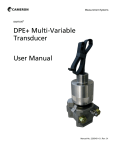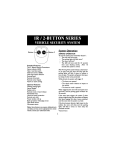Download Radio Shack RS-4000 Installation manual
Transcript
49-840in.fm Page 1 Thursday, August 19, 1999 10:47 AM Cat. No. 49-840 INSTALLATION MANUAL RS-4000 Auto Security Alarm System Read this entire manual before you begin installation. 49-840in.fm Page 2 Thursday, August 19, 1999 10:47 AM INTRODUCTION This installation manual guides you through the steps you will take to install your alarm system. It includes a checklist that keeps you on track and a master wiring diagram that provides an overview of the installation. Plus, this manual has specific, detailed instructions that tell you how to first find connection points, and then how to connect all wires. Refer to the separate Operation Manual to understand each of your alarm’s features and to see how to operate your alarm. Since there are many different makes and models of cars, it is impossible for this manual to cover every wiring configuration. Instead, this manual gives you ways to determine the wiring configuration for your vehicle yourself. We recommend you read through this entire manual first to be sure there will be no surprises during installation. We have included all the mounting hardware you need for installation. However, you need these supplies. • 12-volt test light or volt meter In addition, it would be a good idea to have the following on hand: • Spare vehicle fuses • Spare wire tap-ins and 14-gauge hookup wire (in case a wire does not reach where it needs to reach), available at your local RadioShack store If you have trouble during installation, help is just a toll-free call away. Call the Auto Alarm Helpline anytime at: 1-800-598-2527 if you have any questions or problems. Warnings: • This system produces extremely loud (120 dB) alerts when triggered. Extended, close-range exposure to the siren can be painful and might damage your hearing. • Allow at least 4 to 6 hours for a complete installation. Be sure you have all required supplies before you begin. This installation could require removing door panels and dash access panels, and using a test meter or test light to determine proper installation methods. • Masking tape and a pen • Wire Piercing Probe Adapters (RadioShack Cat. No. 278-715) (Open for Checklist) 1997 Tandy Corporation. All Rights Reserved. RadioShack is a registered trademark used by Tandy Corporation. 2 Need Help? Call 1-800-598-2527 49-840in.fm Page 3 Thursday, August 19, 1999 10:47 AM CHECKLIST Follow this checklist in order and properly identify all connection points before you make any connection. Keep this page folded open as you proceed through the manual. 4 Here 3 after you complete this section: On Page Estimated Time o “Determining Your Vehicle’s Power Door Lock Type” 7 20 minutes o “Determining Your Vehicle’s Door Switch Power Type” 8 20 minutes o o o o o o o o “Finding the Starter Wire” 9 20 minutes “Finding Your Vehicle’s Parking Lights Wire” 10 10 minutes “Finding Constant and Ignition Power” 11 10 minutes “Using Wire Tap-Ins” 11 2 minutes “Mounting the Main Module” 12 10 minutes “Installing the Status Indicator” 12 15 minutes “Mounting and Connecting the Siren” 13 15 minutes “Mounting and Connecting the Anti-Carjacking Switch” 14 20 minutes o o o o o o “Connecting to Power” 14 5 minutes “Connecting the Starter Disable Module” 14 20 minutes “Connecting to Power Door Locks” 15 10 minutes “Connecting to the Parking Lights” 15 10 minutes “Connecting to the Door Switch” 15 10 minutes If you purchased an optional sensor, see “Connecting Additional Sensors” 15 Depends on the sensor o If you purchased an accessory device, see “Connecting Accessory Devices” 16 Depends on the accessory o “Completing the Installation” 16 10 minutes Need Help? Call 1-800-598-2527 49-840in.fm Page 4 Thursday, August 19, 1999 10:47 AM CONTENTS Before You Begin the Installation ................................................................. 5 Using Wire Piercing Probe Adapters ......................................................... 6 Installation ...................................................................................................... 7 Determining Your Vehicle’s Power Door Lock Type .................................. 7 Determining Your Vehicle’s Door Switch Power Type ............................... 8 Finding the Starter Wire ............................................................................. 9 Finding Your Vehicle’s Parking Lights Wire ............................................. 10 Finding Constant and Ignition Power ........................................................ 11 Using Wire Tap-Ins ................................................................................... 11 Mounting the Main Module ...................................................................... 12 Installing the Status Indicator .................................................................. 12 Mounting and Connecting the Siren ........................................................ 13 Mounting and Connecting the Anti-Carjacking Switch ............................. 14 Connecting to Power ............................................................................... 14 Connecting the Starter Disable Module ................................................... 14 Connecting to Power Door Locks ............................................................ 15 Connecting to the Parking Lights ............................................................. 15 Connecting to the Door Switch ................................................................ 15 Connecting Additional Sensors ............................................................... 15 Connecting Accessory Devices ............................................................... 16 Completing the Installation ...................................................................... 16 Specifications ............................................................................................... 17 Master Wiring Diagram ................................................................................ 18 4 Need Help? Call 1-800-598-2527 49-840in.fm Page 5 Thursday, August 19, 1999 10:47 AM BEFORE YOU BEGIN THE INSTALLATION In addition to this installation manual, our car alarm includes the following items. Locate each as you unpack the system. Main Module Two Remote Contols Siren Main Wiring Harness Status Indicator with Bracket and Grommet Two Large Yellow and Seven Small Red Wire Tap-Ins Starter Disable Relay Anti-Carjacking Switch Three Mounting Screws One Large and Four Small Wire Ties Need Help? Call 1-800-598-2527 Double-Sided Tape 5 49-840in.fm Page 6 Thursday, August 19, 1999 10:47 AM Before you install the system, thoroughly read the “Installation” section of this manual. Then decide where to mount the control module and its components and where to route all wiring. Be sure each component’s wires reach from the main control module’s mounting location. These preparations could save you the trouble of remounting and rerouting your alarm system’s wiring and components. To complete the installation, you need to identify and connect to the following parts of your vehicle’s wiring system. If necessary, call 1-800-598-2527 for information about your vehicle’s wiring. USING WIRE PIERCING PROBE ADAPTERS • Chassis Ground • Constant +12 Volts • Accessory Power +12 Volts (only on when vehicle ignition is set to ON or ACC) • Starter Solenoid Ignition Wire from the Key Switch • Power Door Lock Actuation Wires (if you have power door locks) • Door Switch Wire • Parking Lights Wire Fold out this manual’s back cover so you can see the wiring diagram as you make each connection and fold out the front cover and follow the checklist as you install the system. 6 Warning: Installation of this system requires that you modify parts of your vehicle’s electrical system. To safely do this, you must also have information about your vehicle’s electrical system. Before you start the installation, be sure you have an accurate electrical diagram for your vehicle and know how to read it. Most vehicle service manuals include this information. Many procedures in this manual require that you determine the voltage level being carried by an insulated wire. RadioShack Wire Piercing Probe Adapters (Cat. No. 278-715) let you easily do this using a test light or volt meter. Simply slide the adapter onto your test light’s or meter’s probes. Then press the probe’s pointed metal tip through the insulation of the wire you want to test. Need Help? Call 1-800-598-2527 49-840in.fm Page 7 Thursday, August 19, 1999 10:47 AM INSTALLATION DETERMINING YOUR VEHICLE’S POWER DOOR LOCK TYPE There are three basic types of power door locks: Type A: Requires a positive pulse on the lock/unlock control wires to lock or unlock the door. Type B: Requires a ground pulse on the lock/unlock control wires to lock or unlock the door. Type C: Requires a ground pulse on one control wire and a simultaneous positive pulse on another control wire to lock or unlock the door. Follow these steps to determine your vehicle’s power door lock type. 1. Use your vehicle’s service manual, contact your vehicle manufacturer, or contact the Auto Alarm Helpline at 1-800-5982527 to determine where to find the power door lock control wires. They are usually behind a panel near or on the door. 2. Perform each of the following sections, in order, until you successfully identify the switch type (first determine if the switch is a Type C — if it is not Type C, check for Type A — if it is not a Type A, check for Type B). Type C Switch Test Probe both wires. Then operate the door locks. If the light turns on or the meter indicates 12 volts while you operate the switch, the switch is a Type C switch. Call 1800-598-2527 for additional installation information, then proceed to Step 3. Type A Switch Test If the light did not turn on or the meter did not indicate 12 volts, touch one lead from the 12-volt test light or volt meter to one of the control wires and touch the other lead to a metal vehicle chassis part. Operate your power door locks. If the light turns on or the volt meter indicates 12 volts when you move the door lock switch to the LOCK position, you have located a Type A Lock control wire. Test the other wire. If the light turns on or the volt meter indicates 12 volts when you move the door lock switch to the UNLOCK position, you have located a Type A Unlock control wire. Test the other wire (if you have not already done so). If both wires are Type A control wires, go to Step 3. Note: To probe an insulated wire, put wire-piercing probe adapters on your meter or test light leads. Need Help? Call 1-800-598-2527 7 49-840in.fm Page 8 Thursday, August 19, 1999 10:47 AM Type B Switch Test Use the meter or test light to find a point on the fuse block that provides a constant source of +12 volts. Touch one lead to that point on the fuse block, and the other lead to one of the control wires. Operate your power door locks. If the light turns on or the volt meter indicates 12 volts when you move the door lock switch to the LOCK position, you have located a Type B Lock control wire. Test the other wire. If the light turns on or the volt meter indicates 12 volts when you move the door lock switch to the UNLOCK position, you have located a Type B Unlock control wire. Test the other wire (if you have not already done so). If both wires are Type B control wires, go to Step 3. Failed All Tests If you could not determine the power door lock type, call 1-800598-2527 for assistance. 3. Use masking tape to mark each control wire with its function (LOCK or UNLOCK) and type (A, B, or C). 8 DETERMINING YOUR VEHICLE’S DOOR SWITCH POWER TYPE For your alarm system’s passive arming and anti-carjacking features to work, you must connect the alarm to the door switch power lead. Follow these steps to determine the door switch power type. 1. Use your vehicle’s service manual, contact your vehicle manufacturer, or contact the Auto Alarm Helpline at 1-800-5982527 to determine where to access the control wire(s) for your vehicle’s door switch. This wire might also be called a door trigger and is usually behind a panel near or on the door. Notes: • Some vehicles have logiccontrolled dome and courtesy lights that turn on differently depending on which vehicle door is opened. Be sure to locate a wire that is triggered from all your vehicle’s doors. • If your dome light dims slowly when you close the door, your alarm might have problems determining when the door is opened or closed. Contact 1800-598-2527 if this is the case with your vehicle. Need Help? Call 1-800-598-2527 49-840in.fm Page 9 Thursday, August 19, 1999 10:47 AM 2. Touch your meter or test light’s positive lead to a point on the fuse block that has constant 12 volts. Use the other lead to probe the control wire. Then open the door. If the test light turns on or the meter indicates 12 volts, your vehicle has negative-switched door switches. Go to Step 3. Touch the negative lead to a metal chassis part and the positive lead to the control wire. Then open the door. If the test light turns on or the meter indicates 12 volts, your vehicle has positiveswitched door switches. Go to Step 3. If you could not determine the door switch power type, you probably selected an incorrect wire. Contact the Auto Alarm Helpline at 1-800-598-2527 for assistance. 3. Use masking tape to mark the wire with its function (DOOR) and switching type (+ SWITCHED or – SWITCHED). FINDING THE STARTER WIRE To install the starter-kill option, you must find the starter wire (the wire that goes from your vehicle’s key switch to the starter solenoid). Follow these steps to find this wire. 1. Locate the group of wires going from the back of your vehicle’s key switch toward the engine compartment. (These wires are routed along the top of the steering column in many vehicles.) 2. To determine the starter wire’s color, refer to your vehicle’s service manual, contact the vehicle manufacturer, or call the Auto Alarm Helpline at 1-800-5982527. 3. Once you select a wire that you believe is the starter wire, touch one lead from a 12-volt test light or volt meter to a metal part of your vehicle and probe the wire with the other lead. 4. Start your vehicle. The test light or volt meter should indicate 12volts only when you are cranking the engine (not while it is running). If this is not the case, repeat this procedure from Step 3, selecting another wire. Need Help? Call 1-800-598-2527 9 49-840in.fm Page 10 Thursday, August 19, 1999 10:47 AM 5. Turn off the engine. Then cut the wire at a point where there are at least several inches of wire on each side of the cut. Be sure both wire ends are away from all other metal objects under the dash. FINDING YOUR VEHICLE’S PARKING LIGHTS WIRE Important Note: If you cut the correct wire, you will be unable to start your vehicle until you complete the alarm’s installation. To have your parking lights flash during an alert or when you use the car finder, you must connect your alarm system to your vehicle’s parking lights. Follow these steps to find the correct wire. 6. Try to start your vehicle. The engine should not crank. If it does crank, you cut an incorrect wire — use a wire tap-in to restore the connection (see “Using Wire TapIns” on Page 11). 1. Locate the wire harness going from the back of your vehicle’s light control. If the control is on your vehicle’s steering column, the harness probably joins several other wiring harnesses. 7. Use a piece of masking tape to mark each wire end with its function (such as STARTER (TO KEY) and STARTER (TO SOLENOID). 2. Use the vehicle wiring’s color code to find the parking lights wire. To determine the wire’s color, call the Auto Alarm Helpline at 1-800-598-2527. 3. Touch one lead from a 12-volt test light or volt meter to a metal part of your vehicle and use the other lead to probe the wire. 4. Turn on your parking lights. The test light should light or the volt meter should indicate 12 volts only when the lights are on. If this is not the case, repeat this procedure from Step 3, selecting another wire. 5. After you locate the light wire, use a piece of masking tape to mark it with its function (LIGHTS). 10 Need Help? Call 1-800-598-2527 49-840in.fm Page 11 Thursday, August 19, 1999 10:47 AM FINDING CONSTANT AND IGNITION POWER Your system operates from 12 volts and draws up to 15 amps of current. In addition to constant 12 volts, the system needs a source of power that is on only when the ignition is on (usually referred to as ignition power). Follow these steps to find constant and ignition power. 1. Locate the wire bundle going to your vehicle’s ignition switch. 2. There is a large red or striped red wire going to your ignition switch. With the ignition switch in the OFF position, touch one lead from a 12-volt test light or volt meter to a metal part of your vehicle. Use the other lead with a wire-piercing probe to probe the wire. Confirm that the light turns on or the meter indicates 12 volts. USING WIRE TAP-INS We recommend you use wire tap-ins to make all connections. Notes: • Because of the extreme temperatures that occur inside a vehicle, we recommend you never use black electrical tape to insulate a connection. • If you choose to solder connections, use heat-shrink tubing to insulate the connections. • Do not strip either wire when using a wire tap-in. 1. Snap the tap-in’s grooved channel over one of the wires. 3. Mark this wire with its function (CONSTANT POWER). 4. Turn the ignition to ON. Probe for a wire under the dash that has 12 volts only when the ignition is on. Confirm this by turning the ignition on and off while probing each wire. 2. Put the other wire in the other channel. 5. Mark this wire with its function (IGNITION POWER). Need Help? Call 1-800-598-2527 11 49-840in.fm Page 12 Thursday, August 19, 1999 10:47 AM 3. Use pliers to squeeze down the tapping blade. INSTALLING THE STATUS INDICATOR Use the supplied mounting bracket to hold the indicator or drill a hole in the dash. Follow these steps to install the indicator. 4. Close the insulated cover so it snaps. MOUNTING THE MAIN MODULE Select a location for the main module where it is completely concealed and difficult to access after installation. An ideal location is usually under and behind the vehicle’s dashboard on the firewall. Use two of the supplied wire ties to secure the main module under the dash. 1. To use the supplied mounting bracket, use denatured alcohol to clean the surface and let it dry completely. Peel the backing off of one side of the double-sided tape and press it onto the bottom of the bracket. Then peel the adhesive backing from the other side of the tape and press the bracket onto the dash. To mount the indicator in the dash, drill a 1/4-inch hole at the desired location. The surface should be less than 1/8-inch thick. 2. Press the supplied grommet into the mounting hole from the front of the surface. Grommet Indicator 3. Press the indicator into the gromment from behind the surface. 4. Plug the indicator’s plug into the matching jack on the system. 5. Use a supplied wire tie to secure the wire out of the way. 12 Need Help? Call 1-800-598-2527 49-840in.fm Page 13 Thursday, August 19, 1999 10:47 AM MOUNTING AND CONNECTING THE SIREN Once you select a location, follow these steps to mount the siren. Select a location under the vehicle’s hood for the siren. For the best results, the location should meet the following conditions. • The mounting location should be solid and have no mechanisms or moving parts on its other side. • For the loudest siren, the siren horn should point down toward the pavement. • The alarm should not point straight up, as moisture could collect in the siren horn and damage the system. • To prevent water damage, the system should not be mounted in a wheel well, directly behind the radiator grill, or close to the ground. 1. Using the siren’s base as a template, mark the three mounting hole locations. 2. Drill 1/8-inch holes at each mounting location, taking care not to damage anything behind the mounting surface. 3. Secure the siren to the mounting location with two of the supplied mounting screws. 4. Secure the siren’s black wire to a metal part of the vehicle chassis using the third mounting screw. Fully tighten the screw, making sure the wire remains secure. 5. Route the red wire to the main wiring harness. Press the red wire’s connector onto the gray wire’s connector. Need Help? Call 1-800-598-2527 13 49-840in.fm Page 14 Thursday, August 19, 1999 10:47 AM MOUNTING AND CONNECTING THE ANTICARJACKING SWITCH Select a location for the anti-carjacking switch. You should be able to reach the switch when sitting in the driver’s seat, but the switch should be hard to find. A typical mounting location is under the dash. The mounting surface should be less than 1/8-inch thick. Follow these steps to mount the switch. To Harness To Metal Body Part Lockwasher Nut CONNECTING TO POWER Before you connect the system to power, disconnect your vehicle battery’s negative (–) power lead. Note: You must re-enter any programmed information into other electronic devices in your vehicle, such as clocks and radios, after you reconnect the cable. Connect the main wiring harness’s red wire to the wire you marked CONSTANT POWER. Connect the main wiring harness’s black wire to a metal vehicle body part that is not insulated from the main chassis by a plastic part. 1. Drill a 1/4-inch hole in the mounting surface, taking care not to damage anything behind the surface. Connect the main wiring harness’s red wire with black stripe to the wire you marked IGNITION POWER. 2. Remove the switch’s top nut and lock washer. CONNECTING THE STARTER DISABLE MODULE 3. Push the switch into the hole from the back of the mounting surface. Align the switch so ON is away from the driver. Then secure it with the lock washer and nut. 4. Secure the switch’s connector to a metal vehicle body part using an existing screw. 5. Route the other wire to the main wiring harness and plug it into the matching socket on the system. 14 1. Use a yellow wire tap-in to connect the module’s red wire to the wire you marked STARTER (TO KEY). 2. Use a yellow wire tap-in to connect the module’s white wire to the wire you marked STARTER (TO SOLENOID). Need Help? Call 1-800-598-2527 49-840in.fm Page 15 Thursday, August 19, 1999 10:47 AM 3. Connect the module’s orange wire to the bullet connector on the harness’s orange wire. 4. Use a wire tie to secure the module to a nonmoving part under the dash. CONNECTING TO POWER DOOR LOCKS If you have Type C door locks, call 1800-598-2527 for additional information. Follow these steps to connect to Type A or Type B, two-wire door locks. 1. Use a red wire tap-in to connect the main wiring harness’s brown wire with black stripe to the wire you marked either UNLOCK A or LOCK B. 2. Use a red wire tap-in to connect the main wiring harness’s green wire with black stripe to the wire you marked either LOCK A or UNLOCK B. CONNECTING TO THE PARKING LIGHTS This connection makes your vehicle’s parking lights flash during an alert, when you arm and disarm the vehicle, and when you use the car locater. Use a red wire tap-in to connect the main wiring harness’s brown wire to the wire you marked LIGHTS. CONNECTING TO THE DOOR SWITCH This connection lets the alarm know when a door is opened or closed. If you marked the door switch wire DOOR – SWITCHED, use a red wire tap-in to connect the main wiring harness’s black wire with yellow stripe to the door switch wire. If you marked the door switch wire DOOR + SWITCHED, use a red wire tap-in to connect the main wiring harness’s black wire with blue stripe to the door switch wire. CONNECTING ADDITIONAL SENSORS Follow the instructions that come with the sensor to mount and power it. The system requires a connection to ground on the accessory sensor input for activation. If the sensor has a single alarm output, use a red wire tap-in to connect it to either the main wiring harness’s yellow wire (to have the sensor trigger the alarm to sound an alert) or to the harness’s green wire (to have the sensor trigger only warning chirps). Need Help? Call 1-800-598-2527 15 49-840in.fm Page 16 Thursday, August 19, 1999 10:47 AM If the sensor has both warning and alert triggers, use red wire tap-ins to connect the warning trigger to the harness’s green wire and the alert trigger to the harness’s yellow wire. CONNECTING ACCESSORY DEVICES Follow the instructions that come with the accessory to mount and power it. To have the alarm trigger the device when you press TRUNK on the remote, use a relay (not supplied) to connect the device’s control input to the main wiring harness’s white wire with yellow stripe. To have the alarm trigger the device when you press FINDER on the remote, use a relay (not supplied) to connect the device’s control input to the main wiring harness’s white wire with red stripe. Note: Auxiliary switched outputs connect to ground when they are activated. If your auxiliary device requires +12 volts for activation, or if you need help using relays to make these connections, call the Auto Alarm Helpline at 1-800-598-2527 for assistance. 16 COMPLETING THE INSTALLATION Be sure you have the remote control handy, then follow these steps to complete the installation. 1. Reconnect your vehicle battery’s negative (–) battery cable. Note: You must re-enter any programmed information into electronic devices in your vehicle, such as clocks and radios, after you connect the cable. 2. Plug the main wiring harness into the main module. Then immediately press ARM/DISARM on one of the keychain remotes. The alarm should chirp once, the parking lights should flash and the status indicator blinks. The alarm is now armed. Press ARM/ DISARM again to disarm the system. If the alarm does not chirp, immediately disconnect the harness and the vehicle’s negative (–) battery cable. Recheck all connections and check your vehicle’s and the alarm’s fuses to be sure none have blown. If you cannot determine the problem, call 1800-598-2527 for additional assistance. Need Help? Call 1-800-598-2527 49-840in.fm Page 17 Thursday, August 19, 1999 10:47 AM SPECIFICATIONS Sound Pressure Level (w/13.8V DC Power) . . . . . . . . . . . . . 120 dB at 1 Meter Current Draw (System Only, not including parking lights or optional accessories) Standby . . . . . . . . . . . . . . . . . . . . . . . . . . . . . . . . . . . . . . . . . . . . . . 22 mA Siren . . . . . . . . . . . . . . . . . . . . . . . . . . . . . . . . . . . . . . . . . . . . . . . 1.3 Amps Power . . . . . . . . . . . . . . . . . . . . . . . . . . . . . . . . . . . . . . . . . . . . . 8–16 Volts DC Main Power Fuse . . . . . . . . . . . . . . . . . . . . . . . . . . . . . . . . . . . . . . . . . 15-Amp Weight (All components) . . . . . . . . . . . . . . . . . . . . . . . . . . . . . . . 1 lb, 5 ounces Specifications are typical; individual units might vary. Specifications are subject to change and improvement without notice. Electrical Ratings Volts (Max) V+ Ground Starter Kill Siren Lock/Unlock Anti-Carjack Parking Lights (+) Door Pin (–) Door Pin Minor Trigger Major Trigger Indicator Ignition 16 NA Volts (Min) Source (mA) Load (mA, Max) 8 500 3,000 500 4 8,000 16 500 8 8 4 4 20 16 8 Need Help? Call 1-800-598-2527 17 49-840in.fm Page 18 Thursday, August 19, 1999 10:47 AM MASTER WIRING DIAGRAM 18 Need Help? Call 1-800-598-2527 49-840in.fm Page 19 Thursday, August 19, 1999 10:47 AM 2-Wire Status Indicator Harness Red Brown Black Constant +12 Volts In Parking Lights Out (+) Ground In Grey Siren Out (+) Yellow White/Yellow Major Trigger In (–) Button 2 Accessory Out (–) Green Minor Trigger In (–) White/Red Button 3 Accessory Out (–) Black/Blue Positive (+) Door Pin In Black/Yellow Negative (–) Door Pin In Brown/Black Door Lock Out (+ or –) Green/Black Door Lock Out (+ or –) Red/Black Accessory +12 Volts In Orange 1-Wire Anti-Carjacking Switch Harness Need Help? Call 1-800-598-2527 Starter Kill Out (–) Ground In 19 49-840in.fm Page 20 Thursday, August 19, 1999 10:47 AM RadioShack A Division of Tandy Corporation Fort Worth, Texas 76102 7/97 Printed in the USA




























